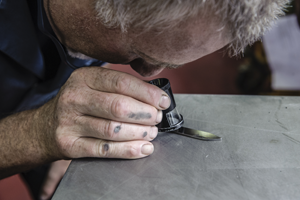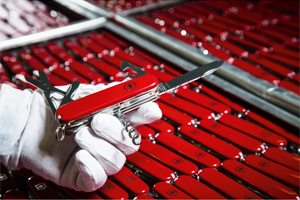Good tools can make everyday life much easier. Screwdrivers, multitools and co. are also very popular as promotional products. So that they are safe to use and the result is satisfying, reliable products are the be all and end all.

Tools not only play a significant role in the lives of professional tradesmen, the average consumer doesn’t get around using a hammer, knife or screwdriver either. Companies that bank on tools as promotional products signalise reliability and pragmatism – of course only under the prerequisite that the products deliver what they promise. In the worst case, using defective equipment to do odd jobs can lead to injuries, frequently however the results of the work are simply not satisfactory or the handling is extremely laborious – which can lead to the user becoming disgruntled.
Yves Dähler, Head of Corporate, at Victorinox knows that the use of all-purpose tools can end in “unpleasant scenes”, if the tool fails when force is applied. In order to eliminate the risks for people’s physical welfare, several factors have to be taken into account during the development and production of tools already. A functional design, high-quality steel, precise workmanship and appropriate final inspections guarantee a highquality product. If these aspects are taken into consideration when the tools are produced, the risks of an unsuitable or even incorrect handling by the consumer are minimised. “A good tool fulfils its purposes reliably when being used and is above all harmless,” stated Dähler. “The products should be manufactured as far as possible so that no harm comes to either the environment or the employees working in the production department. Legal regulations, which forbid or limit the implementation of health-endangering elements such as heavy metals, plasticisers and toxic dyes as well as the guidelines on product safety of course, also have to be abided to.”
In the jungle of the laws
Handheld and machine tools don’t fall under the scope of a corresponding EU guideline, instead the regulations of general product safety that are laid down in Guideline 2001/95/EC of the European Parliament and Council from December 3, 2001 apply. These aim to ensure that the products that are launched onto the European Single Market are harmless for the consumers. Since 2004, members of the European Union are obliged to ensure that the legal and administrative provisions that are necessary to implement the guidelines into national law are in effect.
As a central body of laws for the sales of handheld tools, i.e. the Product Safety Law, based on the EU product safety guidelines applies in Germany. In Austria the guidelines are implemented by means of the Product Safety Law 2004 (PGS), in Italy they are integrated into the consumer protection codex “Codice del consumo”. The European product safety guideline does not specifically apply for handheld tools, but indeed for all consumer products, which is why the safety demands are very general and are enhanced by norms for individual tool groups (see info box for examples). For instance, safety criteria are stipulated according to the latter. These include among others the material quality, which describes the quality of the substances to be processed, the torque value, the safe fastening of handles or the safety factors for rotating tools. Furthermore, the norms specify the lowest quality criteria regarding the durability and service life of the tools. “There are no international or customary industry norms for tools like the ones Victorinox produces, the industry is simply too small for that,” explained Dähler. “This is why we rely exclusively on self-developed tests when inspecting the products, which fall back on the 100 years of experience we have gathered since the development of the first army knife in around 1891. These tests encompass the individual components as well as the finished product. Here it is not just about ensuring the quality of the finishing process, but also about the necessary durability of the products so that the tool can be implemented safely throughout its entire service life. We mainly test using devices that we construct ourselves specifically for the purpose at hand.”

Every pair of scissors has to pass the so-called drop test in order to ensure that it doesn’t splitter or inadvertently stay open.

So that nasty scenes don’t ensue when chopping wood, the demands for tools are defined in the product safety guideline.
The tool manufacturer Fiskars tests its products internally as well as having them inspected by independent testing institutes. “We have our own testing laboratory at our factory in Billnäs in Finland. Here developers test all of the products thoroughly already during the development process, also in the scope of endurance tests,” explained Alexander Francke, Vice President Sales Functional EMEA South at Fiskars. “Products that have already been launched on the market are also tested regularly to improve them. For instance, since 1977 the VPA Remscheid has been testing our tools that are brought onto the German market and certifies them with the seal for tested safety. A common test is for example the drop test for scissors: Here garden shears, sewing scissors or a pair of household scissors are dropped from a pre-defined height onto a hard floor. The scissors or shears are not allowed to open or split even when dropped, otherwise there would be a high risk that the user grasps the blade by mistake when picking them up which could lead to an injury. In the internal testing method of Fiskars the tools are also tested beyond the pure safety aspect: The focus additionally lies on the ergonomics and handling of the products in order to achieve optimal convenience for the user. The aim of the tests is always to guarantee the highest degree of safety and comfort.
If a product fulfils the necessary prerequisites, it is allowed to be certified with the seal for tested safety (GS mark). A finished product is only distinguished if a type examination has been carried out by an approved, independent testing and certification office and this confirms that the prototype corresponds with the safety demands of the European product safety guideline 2001/95/EC. However, the manufacturer not only has to take into account the intended use of his product, but also foreseeable possible uses of his product by the user. If for instance DIY jobs have to be completed fast, pliers are sometimes used as a hammer all of a sudden – this deviating usage also has to be taken into consideration. In order to produce reliable consumer products, the manufacturers, their authorised representatives, importers and distributors have to work closely together with the responsible market surveillance authorities. This approach guarantees that unsafe products are reported to the authorities and that the products ready for use are only awarded the GS mark if the seal was awarded by an approved GS body.


Test seal of the tool industry
Independent to the GS test mark there are in some cases industry-specific test seals such as for instance for forestry tools. The latter are tested in the scope of practical tests in the forest to ensure their suitability. The criteria are for instance the material characteristics, carrying comfort or weight. However, such differentiated test seals don’t exist in all areas of the tool industry. “There are quality seals for individual tools, such as screwdrivers, pliers or also for whole industries such as the forestry industry, however not for multitools,” explained Dähler. At Victorinox a quality seal of a different dimension applies, continued Dähler: “As a family company, the owner family vouches with its name, which is a clear commitment to the highest quality. We don’t want to just offer good and safe products, we want to accompany the customer through life with a comprehensive service package. All employees are very aware of their responsibility, they invest a great deal of passion and resources into the individual production steps, especially in the final inspection. Namely each tool is subjected to a manual final test to make sure everything that leaves our factory corresponds with our quality demand.”
High standard
So, test seals prove to be a good starting point for quality and safety. A further indication for a high product standard is the voluntary manufacturer’s guarantee: Victorinox grants an unlimited guarantee on material and production errors for its pocket knives and multitools, Fiskars grants a warranty of up to 25 years on premium products. “Furthermore, potential buyers should definitely pick up the tools themselves, because one immediately notices a difference in the quality simply by holding them. The price is also a further good indication. As a rule, the offer of premium brands is higher priced, but also of higher quality,” stated Francke. “Of course, in the case of a promotional product the top priority is that the product brings the owner joy – but it should also comply with the image and quality demand of the promoting company. Here Victorinox quite clearly stands for quality rather than quantity,” added Dähler and advised: “It is better to give someone a beautiful rose from the local garden centre rather than a pocket knife with 15 functions for three Euros that falls to pieces as soon as it is unpacked.”
// Joanna Meißner
photos: Fiskars (2), Shutterstock/UfaBizPhoto (1); Victorinox (2)
A norm for every tool
Norms also provide clarity about certain product characteristics in the tool section, facilitate the free movement of goods and set benchmarks, against which background tools are tested to ensure their safety. There are a multitude of standards for the different types of tools. For example the detailed demands placed in gripping and cutting pliers are determined by the international norm ISO 9243:1988 “Pliers and nippers – Carpenter’s pincers – Dimensions and test values”: These include among other things important dimensions such as the length of the handle and blade, as well as the testing values for the pliers to check their functional capacity acc. to ISO 5744. What’s more, the steel of the gripping and cutting pliers has to comply with a minimum hardness of 45 Rockwell (HRC). The norm ISO 1711-1 describes the technical delivery conditions as well as the hardness and test torque that hand-operated screwdrivers and wrench sockets have to satisfy. Independent to the respective spanner gap, there are also pre-defined lengths and widths, which the manufacturers have to comply with. For a spanner gap of 18 mm for instance the overall length has to be between 155 mm and 175 mm and the width has to be 6.5 mm. In addition, the one-time key has to be free from burs and scales as well as permanently protected against corrosion.



